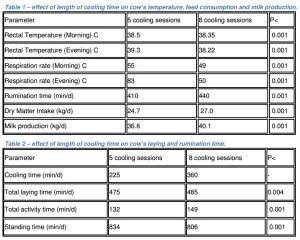Cooling cows improves cow’s welfare and production sustainability
Cooling cows has become a common practice in many dairy sectors in the world, especially in warm regions.
Usually we evaluate the benefits of cooling cows according to its effect on productive and reproductive traits
and the increase in farm’s economical profit. Recently other factors have grown in importance, among them the
impact of heat stress and cows cooling on animal welfare and the environment.
In the future dairy farms will be evaluated not only for their economic efficiency, but also for the way
farmers treat the cows and farm’s contribution, through its production process, to the liberation of
greenhouse gases to the atmosphere and therefore, their impact on global warming (1,2).
The impact of cow cooling on the environment
Usually high production level, partially reached through cooling the cows in the summer, can be
beneficial to the environment. Daily methane gas production per cow and per kg of milk produced by
high yielding cows (averaging over 11,000 kg milk per year), stands at 40% of that of the low
producing cows, usually maintained in pasture part of the year (averaging near 6000 kg of milk per
year).
In a study we carried out in Israel recently, “Green house gases emission balance” was calculated for
the cow cooling practices used on the dairy farms. The increase in CO2 emission to the atmosphere,
due to the use of electricity for fans operation in the cooling process, was compared to the expected
reduction in CO2 equivalent emission to the atmosphere, due to the reduction in number of cows and
heifers required to produce a determined amount of milk. Improved production efficiency and the
reduction in herd size by 5%, due to the increase in milk production, related to cooling the cows in
summer, reduces CO2 emission by 320 kg/cow/year. This reduction was found to be double of that
emitted in the cooling process by the operation of fans and wetting systems (160 kg/cow/year). In
case that the expected increase in annual production due to cooling will reach 10% (a common result
in many dairy sectors in hot regions), the reduction in CO2 emission will reach 4 times that emitted
during cooling process.
Cooling cows in summer, in addition to its beneficial economical effect on increasing production
efficiency and reducing seasonal discrepancy in milk supply, was found to also be environmentally
friendly, by reducing dairy sector contribution to greenhouses effect and global warming.
The impact of cooling on cows welfare
In recent publications we have described the high cost-effectiveness of intensively cooling the cows in
the summer to mitigate heat stress. There is no doubt that cows need intensive cooling in the
Published at Milkproduction.com summer, but does this process and the need to move cows frequently and make them stand more
hours per day to be cooled negatively affect their welfare? The frequency of “moving” the cows to the
holding area and the long periods they spend standing in it, brought Israeli researchers from the
Ministry of Agriculture Research Organization, to investigate whether such relief procedure deprives
cows of required rest (3). Forty two adult high yielding cows were divided into two cooling treatments
groups. Both groups were cooled by combining 30 seconds wetting every 5 minutes and forced
ventilation, for 45 minutes per treatment period. One group was cooled 5 times per day and a total of
3.75 hours (5T), while the other group cows were cooled 8 times per day and a total of 6 hours (8T).
Sophisticated equipment connected to the milking system monitored milk production, feed intake,
body temperature, cows resting and rumination time. Results are described in Tables 1 and 2.

As expected, increasing cooling time increased feed consumption by 2.1 kg/d (8.5%) and daily milk
production by 3.4 kg/d (9.3%). Body temperature and respiration rate were significantly lower in 8T
cows, compared to 5T ones (+ 0.8 C and + 30 respirations per minute at noon time). Unexpectedly,
cows that were intensively cooled and were obliged to stand for longer periods in the “cooling area”,
laid down for more hours per day. If we exclude “obligatory standing time” in longer cooling period
cows, they were found to lay down for almost 10% longer during the 24 hours, as compared to the
shorter cooling period ones. Ruminating time was also increased by 6% in cows of the longer cooling
period group (445 and 415 minutes per day, for 8T and 5T, respectively). What we can learn from these results is that intensively cooling high yielding cows in summer, not
only improves their productivity, but also improves their welfare. Heat stressed cows usually tend to
stand and crowd while cooling the cows more frequently in extremely hot summer days, allows
keeping them in normal thermal conditions for more hours per day, they lay down more time and
probably feel more comfortable.
In conclusion, dairy farmers have to know that when cooling the cows they are not only improving
their farm profitability, but at the same time they improve their cow’s wellbeing, and reduce green
house gas emission to the atmosphere, making their farm more environment friendly.
References: 1. IDF annual meeting 2006, Shanghai, China. Special conference titled “Reduction of Greenhouse Gas Emission at Farm and Manufacturing Levels” , Bulletin 422/2007. 2. First IDF Dairy Summit – The heat is on? , Edinburgh, Scotland, June 2008. (Lecture presented by Dr. Torsten Hemme from IFCN institute in the summit). 3. Honig et al. Performance and welfare of high-yielding dairy cows subjected to 5 or 8 cooling sessions daily under hot and humid climate. J. Dairy Sci. 95:3736-3742. (2012). 4.Israel Flamenbaum Ph. D Published at Milkproduction.com
